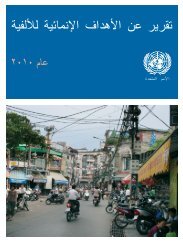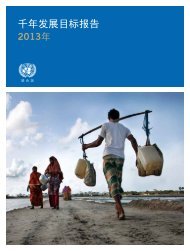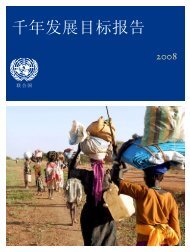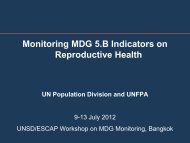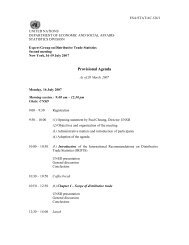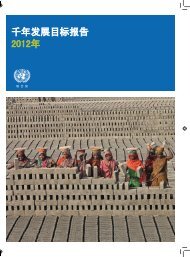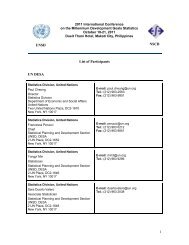demographic yearbook annuaire demographique 1951
demographic yearbook annuaire demographique 1951
demographic yearbook annuaire demographique 1951
Create successful ePaper yourself
Turn your PDF publications into a flip-book with our unique Google optimized e-Paper software.
error in either direction may have an important effect on<br />
the lx values for every age. The expectation of life at birth<br />
(eo) will also be too high or too low.<br />
The accuracy and the international comparability of life<br />
table values are particularly suspect at the highest ages.<br />
Those values depend, as has been said, on imperfect data<br />
and frequently on somewhat arbitrary procedures. Certain<br />
remarkable features-for example, the fact that the expectation<br />
of life at ages over sixty is often distinctly higher in<br />
countries where mortality in general is heavy than in<br />
countries with low death rates-may thus merely reflect<br />
imperfections of the tables.<br />
Differences in the methods used for constructing life<br />
tables (adjustment of data, graduation etc.) may affect the<br />
reliability of the results and impair their international<br />
comparability. The effect of such differences is, however,<br />
probably much smaller than that of deficiencies in censuses<br />
and death registration.<br />
A full evaluation of the life table data presented in this<br />
volume would require a detailed examination of the original<br />
data and computations and a full knowledge of the conditions<br />
of census enumeration and registration in each country.<br />
Such a survey has not been possible; hence no indication<br />
of reliability is given.<br />
INTERNATIONAL MIGRATION<br />
Statistics of international migration are presented in<br />
tables 30 to 34. Table 30 presents overall statistics of international<br />
travellers, classified by major categories of arrivals<br />
or departures; tables 31 and 32 present data on emigrants<br />
and immigrants, classified by countries of origin and destination;<br />
tables 33 and 34 give statistics of emigrants and immigrants,<br />
classified by age and sex.<br />
The materials presented in the tables were, in most<br />
cases, obtained from special communications sent by the<br />
governments to the International Labour Office in reply<br />
to a questionnaire. Supplementary data were extracted by<br />
the United Nations Secretariat from official publications<br />
of the countries concerned.<br />
The problems involved in securing comprehensive and<br />
comparable statistics of international population movements<br />
are quite different from those that arise in connection with<br />
other types of <strong>demographic</strong> data. One of the chief difficulties<br />
is the absence of uniform and practical definitions of the<br />
different types of population movements. For instance,<br />
migrants must be distinguished from all other travellers<br />
crossing international borders. Such a distinction is very<br />
often difficult to establish in practice and in most cases<br />
can only be made on the basis of declared intention regarding<br />
length of stay, exercise of an occupation etc. As used<br />
in the tables, the term "permanent emigrants" refers in<br />
general to residents departing for a stay of a year or more;<br />
"permanent immigrants" are non-residents arriving for a<br />
year or more as well as residents so arriving after an absence<br />
abroad of a year or longer. "Temporary immigrants" are<br />
non-residents intending to exercise an occupation for a<br />
limited period of time (usually less than a year) and their<br />
dependents. In general, the line between "permanent" and<br />
"temporary" or between "migrant" and "visitor" is drawn<br />
at twelve months. Deviations from and modifications of<br />
the above general concepts are explained in the footnotes;<br />
so also are any other terms or concepts used. 13<br />
13 For a fuller discussion of these difficulties, see United Nations<br />
Problems of Migration Statistics ST/SOA/Series A. Population Studies,<br />
No.5, Lake Success, New York, November 1949.<br />
Data are required on movements of all peoples across<br />
national frontiers if it is to be possible to combine statistics<br />
of international population movements and of natural increase<br />
to obtain a complete analysis of the changes observed<br />
in the course of time in the size and structure of a given<br />
population. An overall coordinated set of figures on international<br />
movements of people departing and arriving, classified<br />
by major categories of movement, presents also great<br />
interest for the interpretation of the total figures corresponding<br />
to anyone of the categories of movements, in particular<br />
those for permanent and temporary emigrants and<br />
immigrants. These data should, consequently, facilitate<br />
comparisons between different countries and years. Data<br />
of this type are presented in table 30 for 19 areas for the<br />
years 1946-1950 and it is hoped that, in spite of their<br />
limitations, they may prove useful in clarifying the nature<br />
of the data on migration presented in the more detailed<br />
tables that follow.<br />
The nomenclature used in the table for major categories<br />
of departures and arrivals is based upon that suggested<br />
by the Population and Statistical Commissions in the Draft<br />
Recommendations for the Improvement of International<br />
Migration Statistics drawn up in 1949. 14 This nomenclature<br />
was used by the International Labour Office in requesting<br />
migration data from countries and is as follows:<br />
I. Departures (except frontier traffic)<br />
A. Total departures.<br />
E. Permanent emigrants (i.e., residents departing<br />
permanently) .<br />
C. Temporary immigrants departing (departures of<br />
persons who, on arrival, were classified in category<br />
CC).<br />
D. Residents departing temporarily.<br />
£. Visitors departing (departures of persons who,<br />
on arrival, were classified in category EE).<br />
Special classes<br />
(i.e., refugees, deportees etc.).<br />
II. Arrivals (except frontier traffic)<br />
AA. Total arrivals.<br />
BE. Permanent immigrants.<br />
CC. Temporary immigrants (i.e., non-residents intending<br />
to exercise temporarily an occupation<br />
and their dependents).<br />
DD. Residents returning after temporary sojourn<br />
abroad (arrivals of persons who, on departure,<br />
were classified in category D).<br />
EE. Visitors (in transit, on holiday, on business, for<br />
education, for other purposes).<br />
Special classes<br />
(i.e., refugees, deportees etc.).<br />
III. Frontier traffic<br />
In compiling table 30 it was found that the description of<br />
the categories used by some countries differ from the standard<br />
definitions given above. In such cases the description<br />
supplied by the countries are used. For this reason also the<br />
reference letters are omitted in the table. Further, in order<br />
to save space, the full designation of the categories is not<br />
repeated in the table; similarly, where figures for only one<br />
or two categories are available, the other categories are not<br />
listed for that particular country. The definitions ofthe terms<br />
"permanent" and "temporary" provided by the countries<br />
14 See: Report of the Population Commission, Fourth Session, United<br />
Nations document E/1313, 21 April 1949, Annex 3 (Mimeographed).<br />
38





